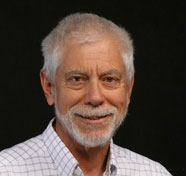

By Robert Wolf
Decorah, IA, USA

Robert Wolf
On that summer morning of 1966, just as I stepped inside his front-room gallery Hal said, “Come in.” I walked into the adjoining kitchen and sat opposite him at his small wood table. He handed me a mimeographed paper and asked, “What do you make of this?” The paper claimed to describe certain homegrown communist threats within America. I said, “Might be,” but really did not believe the claims. “Makes sense to me,” Hal said.
I thought perhaps he was a conspiracy nut, but he was not. That was the one and only time he ever mentioned anything even remotely connected to politics.
He asked if I would have breakfast with him and I said yes. He fried some eggs in an old iron skillet and made toast and coffee. His cooking range was an old high-backed wood-burning stove with lids, converted to gas. His coffee pot was huge and blue, speckled with white. The coffee was strong and acidic.
I realized I had entered another world. This was not the world of New Canaan, which was a world of clocks, appointments, deadlines, and responsibilities, a world of serious people. This was something far more real. It was relaxed, but that was because in those days Santa Fe—that portion of it that grew from Hispanic and Indian roots and was nurtured by the early Anglo artists—was not dominated by time. Within a dozen years that would change, but in 1966, at least, I was living outside the strictures of New Canaan.
Tom, Ross, and I had a dinner club at our college, St. Johns, to which we invited area artists and writers, one of whom was Jack Schaefer, the author of Shane.
While Hal cooked I said, “Jack Schaefer told me and some of my friends about you. And your sons, especially Archie. He spoke very highly of Archie. Said he was one of the last working cowboys in this area.”
“Jack Schaefer,” Hal mused. “I haven’t seen ole Jack in quite a while. So he spoke about Archie.”
“Yes.”
“Archie’s a good boy. He works hard. He runs a little ranch south of here.”
He told me to get forks, spoons, knives, and plates from the cabinet and drawer in back of me. The plates were old and cracked, no two alike, and the utensils were worn. I laid them out and Hal served the food.
After we ate and were sitting around smoking, the front screen door opened and Ross boomed out, “Is Hal West here?”
“He’s in the kitchen,” Hal said, and Ross and Tom ambled inside.

Hal West
“Hello,” Tom said.
They stood in the kitchen doorway.
“Come on in. Pull up some chairs, boys, and set down,” Hal said.
The two of them sat and introduced themselves and Hal said, “Nice to know you boys.”
“We’ve heard of you,” Ross said.
“Is that so?” Hal said. “Would you like some coffee?”
“Sure.”
“Just get yourselves some cups from that cabinet,” Hal said, nodding to indicate it.
“Are those your paintings in the front room?” Tom asked.
“They are,” Hal said. “Have a look.”
We looked around the front room, admiring the paintings, which were mostly of a by-gone era and mostly of Oklahoma and New Mexico—paintings of an abandoned homestead, cotton pickers, farmers plowing behind mules, a hitchhiker sitting on a suitcase alongside an empty highway, country people standing outside a frame house at night with the stars out. The paintings told stories.
When we stepped back inside the kitchen, Hal said, “Do all three of you go to St. John’s?”
I had already told Hal that I did.
“Yes.”
“Well, that’s good. Do you expect you’re educated enough to play a game of dominoes?”
“It’s a game?” I asked.
“Yes,” he said. “Would you like to try it?”
“Sure,” we said, and he rolled back his chair, opened the table drawer, took out a small cardboard box and dumped the dominoes across the table. “Get ‘em all upside down so the dots don’t show.” We did that. “Now I mix ’em up real good so no one with a sharp eye and a dishonest nature might be tempted.” Then he told us how to play.
Such an encounter between an elderly adult and three youths, let alone one youth, would not have occurred in New Canaan, or Darien, or Greenwich. Adults in these towns were serious. It would have been beneath the dignity of an ad agency account executive to play dominoes with his son and the sons’ friends. Or for a mother to play with her daughter and her friends. Adults lived in a world apart. In fact, my father did most of the time, literally, traveling on business across the states and in Europe.
Life in Santa Fe was fairly spontaneous and somewhat disorderly. People, of course, had jobs but there was a sense of continuous socializing, particularly in bars. If you took a notion to visit someone, you didn’t call, you just showed up. The formalities of New Canaan and like towns did not exist in Santa Fe. At the time I arrived, in 1965, not a few of the wealthy were a part of the bohemian scene. Santa Fe was not exactly a seamless fabric, but there was still a lot of socializing across ethnic and social lines. At Hal West’s home and studio, any number of characters might show up.
From that first meeting I spent every day for the next three months at Hal’s, sometimes writing, sometimes painting, sometimes drinking coffee and listening to the people who dropped by. Meeting these people was a big part of my education, and none of them would have been at home in New Canaan or any other bourgeois enclave.
Link:
Free River Press
American Mosaic with Robert Wolf




